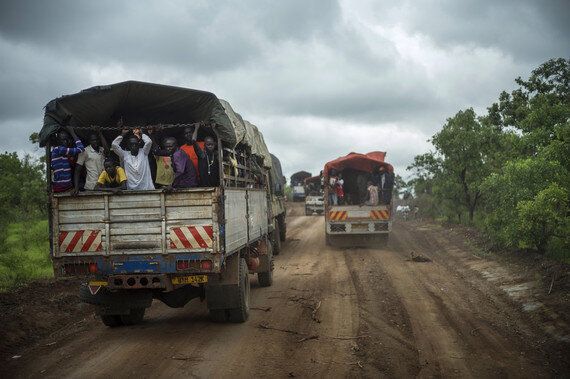Twenty years ago, Nikki van der Gaag, now Director of Gender Justice and Women's Rights at Oxfam, visited Ikafe, a refugee settlement in northern Uganda. As the one millionth South Sudanese refugee flees into Uganda, Nikki remembers the people she met and looks at what has changed.

Refugees travelling to their new settlements. Credit: Kieran Doherty / Oxfam
It is Alice I remember best. Alice was the Women's Representative on the Refugee Council at Ikafe settlement in northern Uganda, right on the border with what was formerly Sudan.
It was 1996, and I was a journalist, there to write a story for New Internationalist magazine about the refugee settlement run by Oxfam and its partners.
Alice had a warm smile, and as warm a welcome. We had many discussions in the tukul (traditional round hut) that was her home, and as we walked and cycled together around the settlement.
We talked about her life, about men's and women's roles - and how they changed in refugee situations. She laughed a lot. But she also had harrowing stories to tell.
In 1993 she had fled the fighting between Sudanese Government forces and the Sudanese People's Liberation Army, who wanted their own country. Her husband had died in 1991, leaving her to run on foot with her mother and small daughter Beatrice. They were happy to reach the safety of Ikafe, which the Ugandan Government had asked Oxfam to set up in 1994.
Unlike many in Europe, Uganda is a country that has always welcomed refugees - and continues to do so.
This week, the one millionth South Sudanese refugee fled into Uganda, escaping the conflict that continues to wreak havoc since it erupted in South Sudan in 2013, only two years after the country gained independence. More than 86% of Sudanese refugees are women and children.
Bidibidi, the section of Ikafe where I stayed, has swelled since it reopened just one year ago to become the largest refugee settlement in the world, hosting over 270,000 people - almost six times the number there were 20 years ago. It has now closed its doors to new arrivals due to lack of space.
Bidi Bidi and the other refugee sites are called settlements, not camps, as Uganda's policy is for each family to have a tukul rather than a tent, plus a piece of land to grow food.
Such a generous offer can put a strain on the local population, many of whom face their own struggles. When I visited Ikafe, the Ugandans who lived in that area had previously been refugees in Sudan, in a cycle that went back to the 1960s.
People like Oxfam worker Izarugu, who left Uganda for Sudan in 1982 because of the conflict in his own country. Izarugu had been reluctant to leave his home with his pregnant wife and child.
It was not until 1985 that they were able to come back to Uganda. He told me: 'It was hard going back; some of us could not recognise the places that had been our homes."
By 1994, Izarugu was with Oxfam, welcoming Sudanese refugees back to his own country. Having been a refugee yourself breeds understanding, but with so many people arriving, it can also lead to tensions, especially if the refugees are arriving in huge numbers. And the numbers are enormous.
Today, Uganda has the biggest refugee population in Africa, and is the third biggest refugee host in the world. Alongside the South Sudanese refugees, there are 300,000 from Burundi, the Democratic Republic of Congo, Central African Republic, and Kenya.
Uganda is not a rich country, and the resources being offered to support its generosity are woefully low. The UN's 2017 South Sudan Refugee Response Plan alone requires over $670 million. By June this year, only 17% of the amount had been received. The response for Burundian refugees in Uganda has not received any funding at all.
This massive funding gap hurts not only refugees, but also Ugandan host communities on the front lines of the response. The number of arrivals increasingly puts Uganda's open door policy under threat.
No-one wants to be a refugee. What Sudanese like Alice and Ugandans like Izarugu really want is simple, and is what all humans hope for - to live in peace in your own home and country, without fear. But for those in northern Uganda, this must seem as far away today as it was 20 years ago - or perhaps even further.
And Alice? I know that she got back to Juba; perhaps 15 years ago, I received a handwritten letter through the post via Oxfam. I wrote back, but never had a reply. I realise that if she is still alive, she is quite likely to be back in Uganda. Alice, if you read this, I wonder what you have been through since we met. And I wonder if you remember me too.